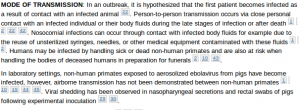As I touched on in the previous post, I recently came across some websites that reported that the Canadian Public Health Agency had recently changed the description on their website of research that suggests that Ebola can be spread through the air. The changes soften what was once an alarming statement about the spread. Here’s the August 2014 version:
“In he laboratory, infection through small-particle aerosols has been demonstrated in primates, and airborne spread among humans is strongly suspected, although it has not been conclusively demonstrated.”
Now here’s the September 2014 version:
“In laboratory settings, non-human primates exposed to aerosolized ebolavirus from pigs have become infected, however, airborne transmission has not been demonstrated between non-human primates.”
No explanation was provided for the change in the wording, which removed “strongly suspected” and changed “not been conclusively demonstrated” into “not been demonstrated.”
Now, aside from the obvious fame and fortune, being a Wikipedia editor has also brought me an inclination for checking references. There are several sources cited for each version.
The August version lists these citations (1,6,13):
Plague. (2004). In R. G. Darling, & J. B. Woods (Eds.), USAMRIID’s Medical Management of Biological Casualties Handbook (5th ed., pp. 40-44). Fort Detrick M.D.: USAMRIID.
Mwanatambwe, M., Yamada, N., Arai, S., Shimizu-Suganuma, M., Shichinohe, K., & Asano, G. (2001). Ebola hemorrhagic fever (EHF): mechanism of transmission and pathogenicity. Journal of Nippon Medical School = Nihon Ika Daigaku Zasshi, 68(5), 370-375.
Feigin, R. D. (Ed.). (2004). Textbook of Pediatric Infectious Diseases (5th ed.). Philadelphia, USA: Elsevier, Inc.
Interestingly, the September a citation list almost completely different ( Footnote 1 Footnote 10 Footnote 15 Footnote 44 Footnote 45.
Plague. (2004). In R. G. Darling, & J. B. Woods (Eds.), USAMRIID’s Medical Management of Biological Casualties Handbook (5th ed., pp. 40-44). Fort Detrick M.D.: USAMRIID.
Mwanatambwe, M., Yamada, N., Arai, S., Shimizu-Suganuma, M., Shichinohe, K., & Asano, G. (2001). Ebola hemorrhagic fever (EHF): mechanism of transmission and pathogenicity. Journal of Nippon Medical School.68(5), 370-375.
Bausch, D. G., Jeffs B.S.A.G, & Boumandouki, P. (2008). Treatment of Marburg and Ebola haemorrhagic fevers: a strategy for testing new drugs and vaccines under outbreak conditions. Antiviral Res., 78(1), 150-161.
Reed, D. S., Lackemeyer, M. G., Garza, N. L., Sullivan, L. J., & Nichols, D. K. (2011). Aerosol exposure to Zaire ebolavirus in three nonhuman primate species: differences in disease course and clinical pathology. Microbes and Infection, 13(11), 930-936.
Twenhafel, N. A., Mattix, M. E., Johnson, J. C., Robinson, C. G., Pratt, W. D., Cashman, K. A., Wahl-Jensen, V., Terry, C., Olinger, G. G., Hensley, L. E., & Honko, A. N. (2012). Pathology of experimental aerosol Zaire ebolavirus infection in rhesus macaques. Veterinary Pathology Online, 0300985812469636.
Interestingly, neither version of this section cites the alarming study the Canadian Public Health Agency’s own researchers conducted in 2012 which suggests airborne transmission of Ebola. That citation is #46 in the article:
Weingartl, H. M., Embury-Hyatt, C., Nfon, C., Leung, A., Smith, G., & Kobinger, G. (2012). Transmission of Ebola virus from pigs to non-human primates. Scientific reports, 2.
The Twenhafel study cited above appears to be based on the Weingartl study and was published in December 2012. Rather than disprove the Weingartl study, the Twenhafel study highlights the pathogenesis of the virus, marveling in its efficiency.
So what changed between August and September to warrant watering down the language? The citations certainly don’t tell the story. Most of the articles cited predate the 2012 Twenhafel study. Neither version even cites the Twenhafel study.
Did the researchers suddenly have second thoughts a full two years after their report was published in the peer-reviewed journal Scientific Reports. Dr Gary Kobinger, who participated in the study, seemed pretty convinced when interviewed by the BBC at the time:
“What we suspect is happening is large droplets – they can stay in the air, but not long, they don’t go far,” he explained.
“But they can be absorbed in the airway and this is how the infection starts, and this is what we think, because we saw a lot of evidence in the lungs of the non-human primates that the virus got in that way.”
Still, Dr. Kobinger did stress that this transmission isn’t like influenza:
“The reality is that they are contained and they remain local, if it was really an airborne virus like influenza is it would spread all over the place, and that’s not happening.”
With the news that Saturday one of the nurses treating Thomas Duncan, 26-year-old Nina Pham, has fallen ill to Ebola, Dr. Frieden of the CDC blamed a “breach of protocol” on her infection. On Sunday, Dr. Freiden backpedaled on his placing the blame:
Frieden also apologized for remarks on Sunday, when the nurse’s infection was first disclosed, that suggested she was responsible for a breach in protocols that exposed her to the virus. Some healthcare experts said the comments failed to address deep gaps in training hospital staff to deal with Ebola.
“I’m sorry if that was the impression given,” Frieden said. He said the agency would take steps to increase the awareness of Ebola at the nation’s hospitals and training for staff.
How is it that a well-trained nurse in a state-of-the-art Western hospital who claimed to be following proper procedure still become infected with Ebola? I wonder just what the experts know that we don’t know.

